We recently put up new posters outside the Biochemistry undergraduate laboratories to entertain the students as they wait for classes to start, and show them the kinds of things they could do if they continue their research adventures with the department.
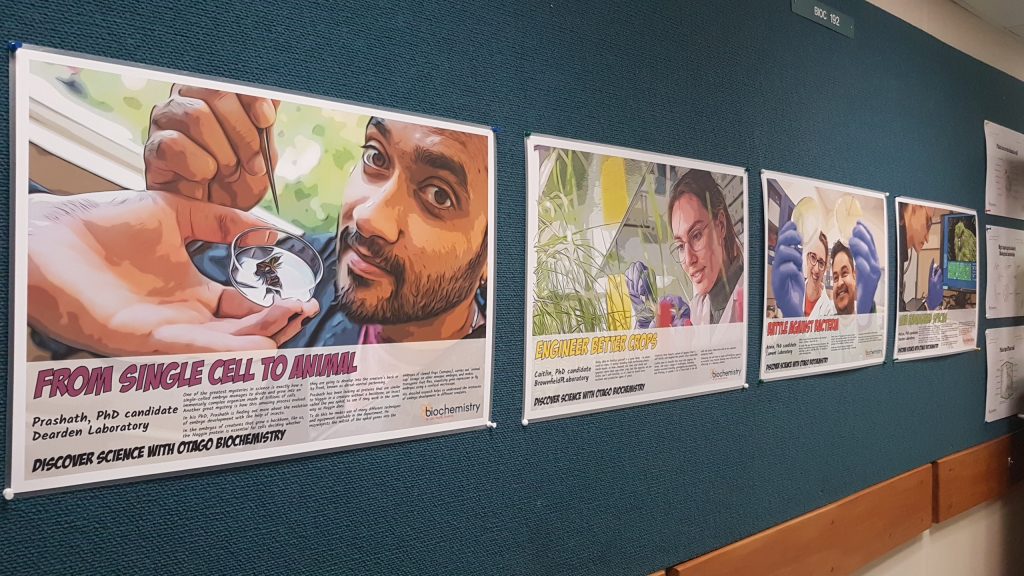
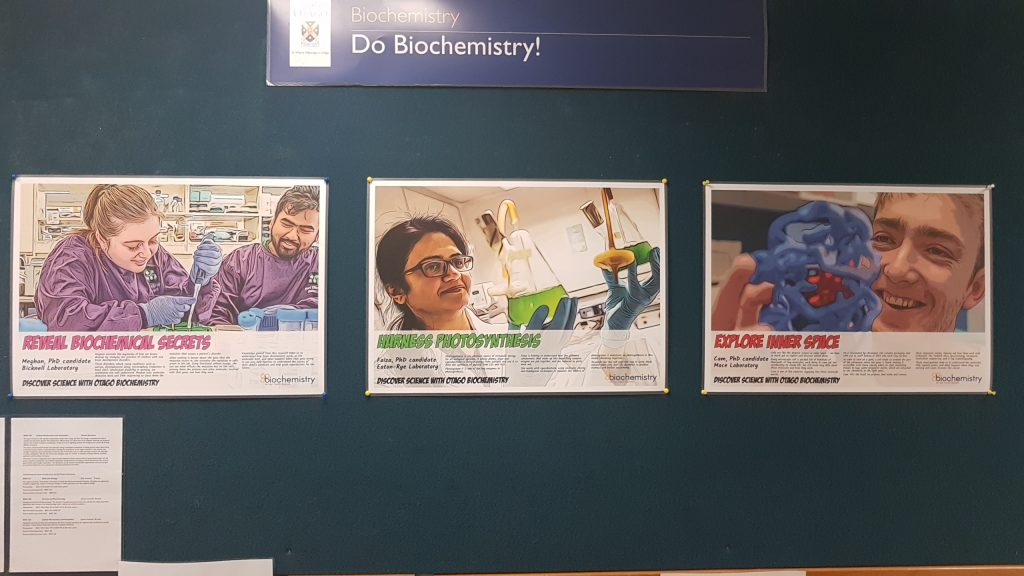 We thought we’d share these posters with you. They feature seven of our current and recent PhD students and give a quick overview of what they are studying.
We thought we’d share these posters with you. They feature seven of our current and recent PhD students and give a quick overview of what they are studying.
The pictures are based on the amazing photos that Sharron Bennett took in the department last year. Thanks Sharron! www.sharronbennettphotography.com
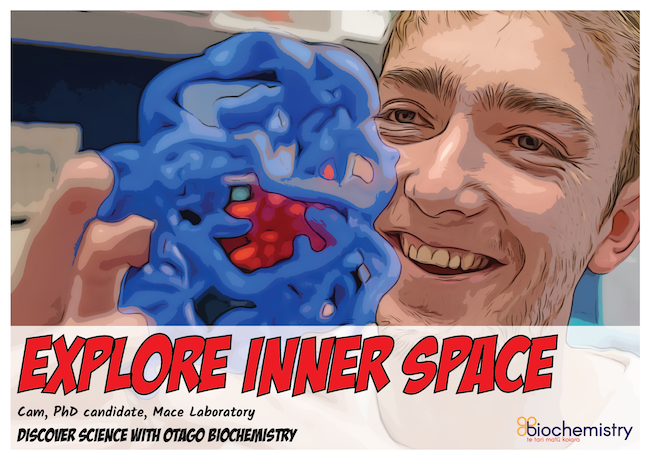 Cells are like the deepest oceans or outer space – we have so much yet to explore and discover within them. Every microscopic cell is packed full of hundreds of thousands of tiny molecules, each doing its own job and coordinating to create life. We still know very little about these molecules and how they work.
Cells are like the deepest oceans or outer space – we have so much yet to explore and discover within them. Every microscopic cell is packed full of hundreds of thousands of tiny molecules, each doing its own job and coordinating to create life. We still know very little about these molecules and how they work.
Cam is one of the explorers voyaging into these miniscule worlds.
He is fascinated by chromatin, the complex packaging that cells use to stuff metres of DNA into each tiny nucleus. In order to turn on a gene, a cell needs to unwind the part of the chromatin where the gene is found, making it accessible. Cells know exactly where to start unwinding thanks to tags called epigenetic marks, which are attached to the chromatin in the right spots.
Cam ‘lifts the hood’ on proteins that make and remove these epigenetic marks, figuring out how they work with techniques like TurboID mass spectrometry, chromatin localisation sequencing, and X-ray crystallography.
These investigations help us to understand the molecules that regulate genes, and what happens when they stop working and cause diseases like cancer.
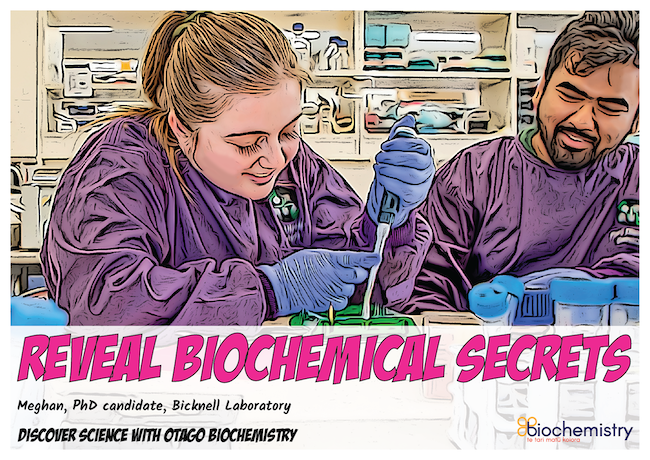 Meghan unravels the mysteries of how our brains develop by studying the genetics of children with rare brain development disorders.
Meghan unravels the mysteries of how our brains develop by studying the genetics of children with rare brain development disorders.
These disorders, which cause conditions such as autism, developmental delay, microcephaly (reduction in head size), intellectual disability or epilepsy, are sometimes not well understood. Meghan uses molecular detective work and DNA sequencing to track down the mutation that causes a patient’s disorder.
When nothing is known about the gene that the mutation occurs in, she recreates the mutation in cells grown in the lab. Using functional cellular assays, she can see what effects the mutation has on the cells, pinning down the proteins and other molecules involved with that gene, and how they work.
Knowledge gained from this research helps us to understand how brain development works at the molecular level, and what happens when that goes wrong. It can also help families to understand the causes of their child’s condition and help guide expectations for the future.
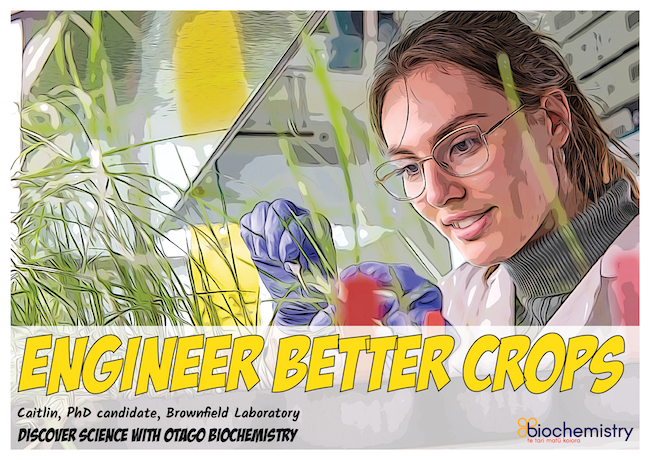 Being able to fertilise yourself is a good thing – in plants used as crops. It makes breeding high performing plants much easier. In New Zealand, our cows and sheep eat ryegrass more than any other crop, but the ryegrass on our farms can’t self-fertilise, so it’s hard to breed more resilient and productive types of grass.
Being able to fertilise yourself is a good thing – in plants used as crops. It makes breeding high performing plants much easier. In New Zealand, our cows and sheep eat ryegrass more than any other crop, but the ryegrass on our farms can’t self-fertilise, so it’s hard to breed more resilient and productive types of grass.
Scientists have found a variant of ryegrass that is self-fertile, and mapped the genetic locus responsible.
Caitlin aims to transfer this locus into ryegrass for farms. She uses a range of techniques, including marker-assisted breeding, genotyping-by-sequencing, and RNAseq, so spends a lot of time both in the lab with the plants themselves and on her computer, analysing results.
Ultimately she will help to make self-fertilising ryegrass, an essential step towards farming more efficiently and effectively in a changing climate.
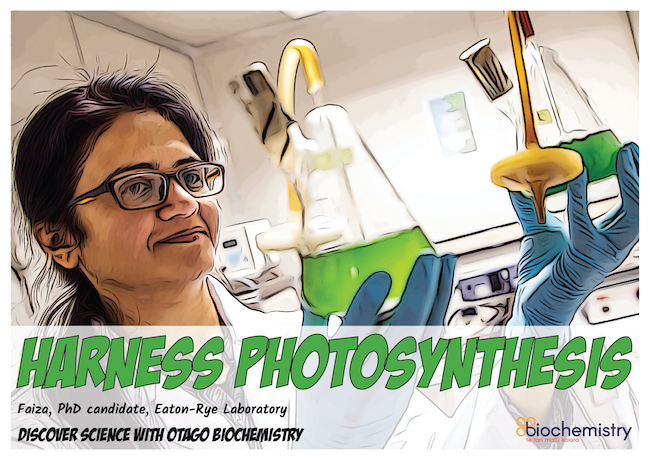 Photosynthesis is the ultimate source of metabolic energy for all biological systems. It allows plants, algae, and cyanobacteria to harvest energy from sunlight and use it to drive the synthesis of glucose from CO2 and H2O.
Photosynthesis is the ultimate source of metabolic energy for all biological systems. It allows plants, algae, and cyanobacteria to harvest energy from sunlight and use it to drive the synthesis of glucose from CO2 and H2O.
Photosystem II is one of the key enzymes in photosynthesis.
Faiza is helping to understand how the different components that make up this beautifully complex enzyme are put together and are replaced as parts wear out.
She works with cyanobacteria, using molecular cloning and biophysical techniques to measure the effects of photosystem II mutations on photosynthesis in this model laboratory organism.
Research like this will pave the way to using these natural solar cells and CO2 absorbers to produce biomass and biofuel sustainably.
 Hundreds of years ago, night-time across Aotearoa echoed with low-pitched booming noises – the mating call of a quirky nocturnal parrot called the kākāpō. Our nights are now quiet and this special bird is critically endangered, thanks to the devastating impact of introduced predators.
Hundreds of years ago, night-time across Aotearoa echoed with low-pitched booming noises – the mating call of a quirky nocturnal parrot called the kākāpō. Our nights are now quiet and this special bird is critically endangered, thanks to the devastating impact of introduced predators.
With an intensive recovery programme, the kākāpō population is growing, but all of the birds are descended from just 32 individuals, so inbreeding is causing problems. Many eggs are infertile and many chicks die during development. Kākāpō need more help.
Marissa is part of a team that is sequencing the genomes of every living kākāpō, revealing their remaining genetic diversity.
Using models based on this genomic data, she predicts the impact of different breeding management strategies on kākāpō inbreeding.
Marissa is also testing a new portable sequencing device, the Nanopore, which is less expensive and will allow conservationists to gather kākāpō genetic data in the wild. This will provide important information such as the sex and parentage of chicks where and when it is needed.
Marissa’s research will help guide kākāpō breeding management strategies, and provide easier access to genetic data for conservation, hopefully increasing numbers of the treasured parrot.
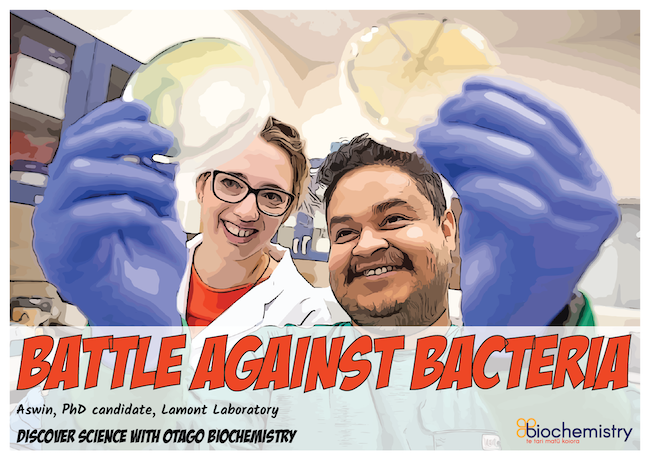 What do you do when the antibiotics stop working? Aswin is helping to figure that out.
What do you do when the antibiotics stop working? Aswin is helping to figure that out.
He studies the ways that Pseudomonas aeruginosa, the bacteria responsible for many nasty hospital-acquired infections, is able to avoid the effects of antibiotics called aminoglycosides.
Some strains of P. aeruginosa have genes encoding proteins that pump the antibiotic out of the bacteria cells. Or they may acquire genes that modify the structure of the antibiotic, rendering it useless.
Aswin uses molecular cloning techniques and bioinformatic tools to study the effects of knockouts or mutations in these antibiotic resistance genes.
Research like his into what exactly makes bacteria resistant to an antibiotic is essential to help find ways to overcome the growing global threat of antibiotic resistance.
 One of the greatest mysteries in science is exactly how a single-celled embryo manages to divide and grow into an immensely complex organism made of trillions of cells. Another great mystery is how this amazing process evolved.
One of the greatest mysteries in science is exactly how a single-celled embryo manages to divide and grow into an immensely complex organism made of trillions of cells. Another great mystery is how this amazing process evolved.
In his PhD, Prashath is finding out more about the evolution of embryo development with the help of insects.
In the embryos of creatures that grow a backbone, like us, the Noggin protein is essential for cells deciding whether they are going to develop into the creature’s back or its front, known as dorsal-ventral patterning.
Prashath has been looking at proteins that are similar to Noggin in a creature without a backbone, an insect called the pea aphid, to see if they work in the same way as Noggin does.
To do this he makes use of many different techniques and equipment available in the department. He microinjects the mRNA of the aphid genes into the embryos of clawed frogs (xenopus), carries out ‘animal cap’ assays on other xenopus embryos, and makes transgenic fruit flies, visualising gene expression in fly embryos using a confocal microscope.
His detailed research helps us understand the intricacies of embryo development in different creatures.

